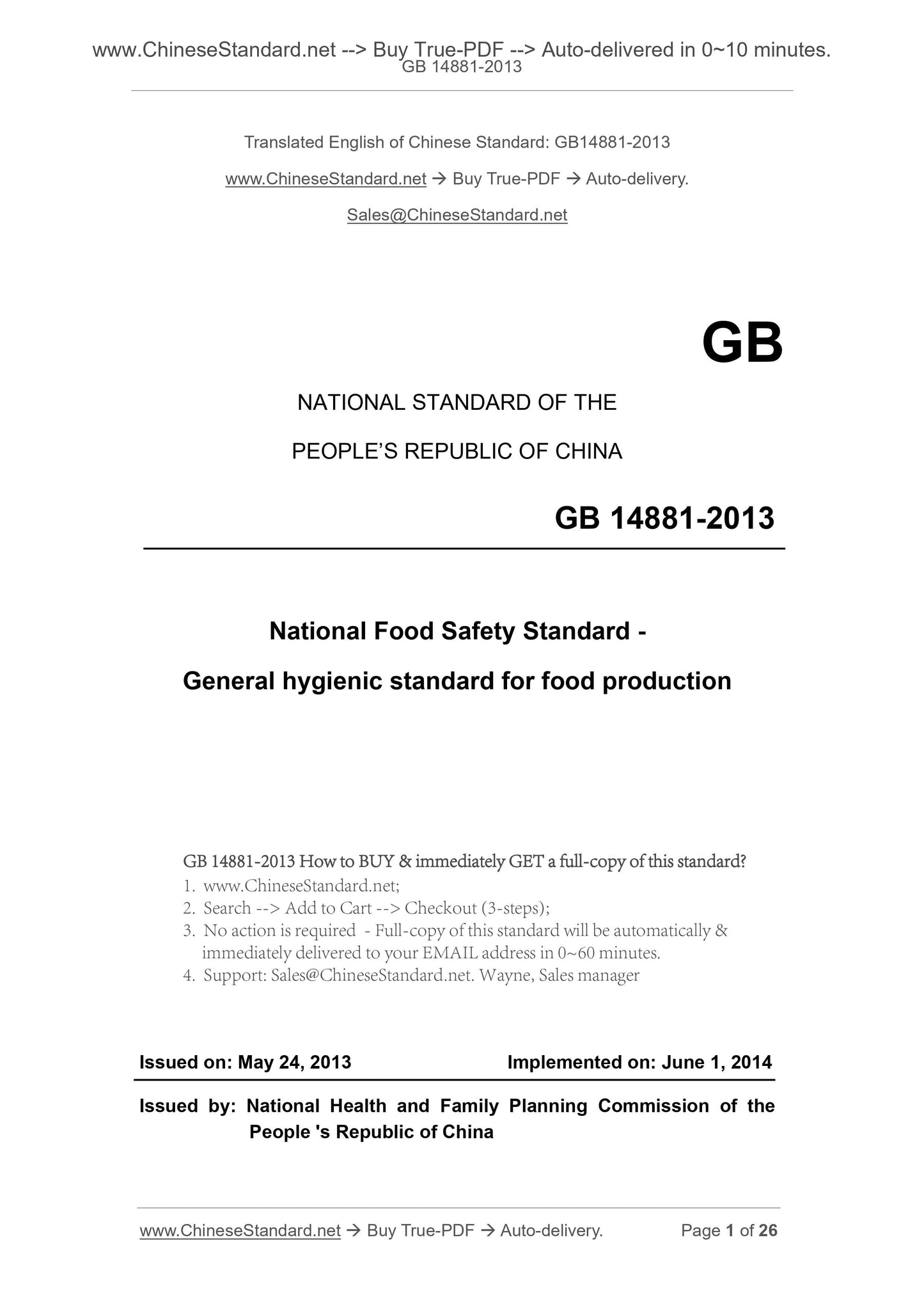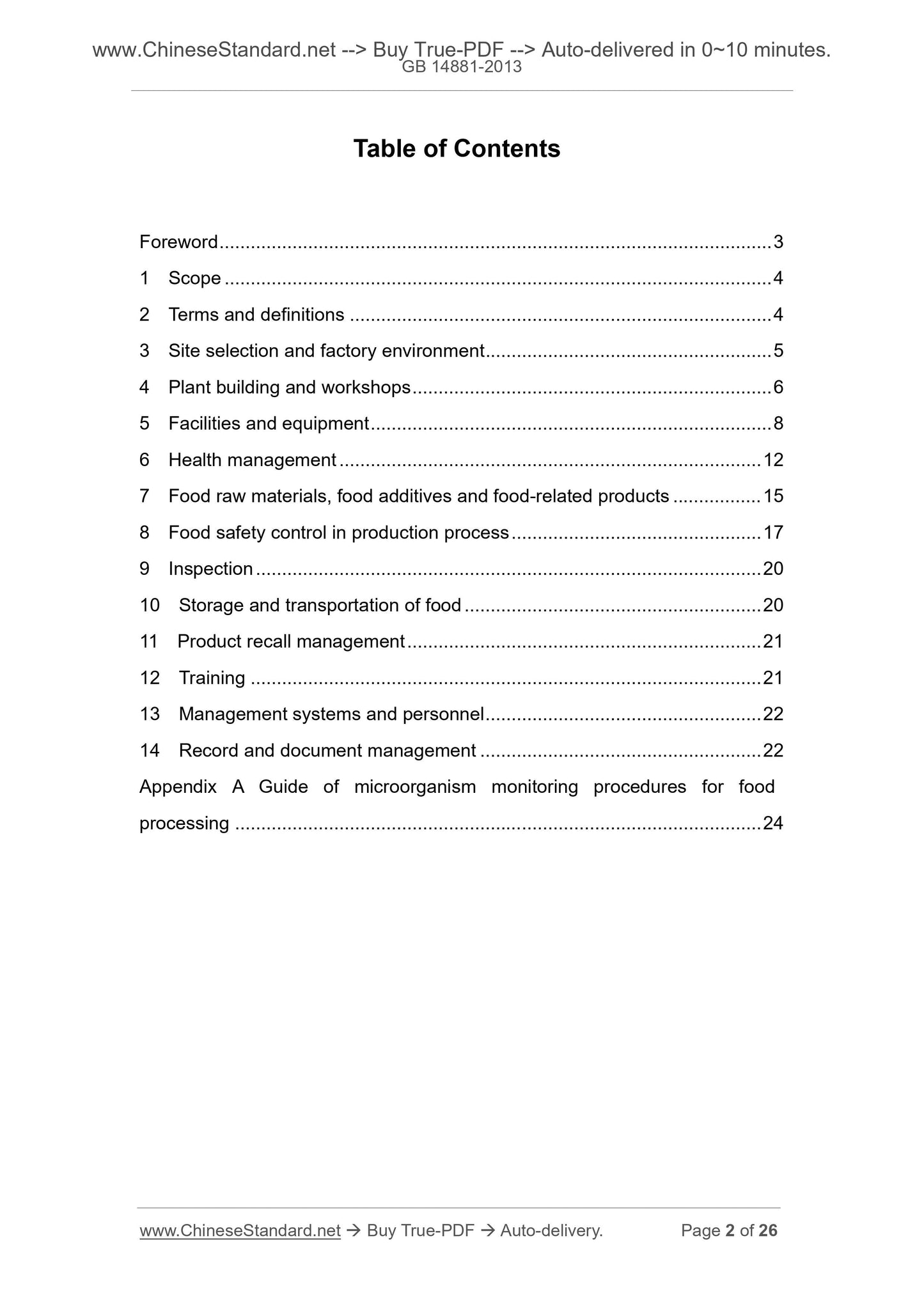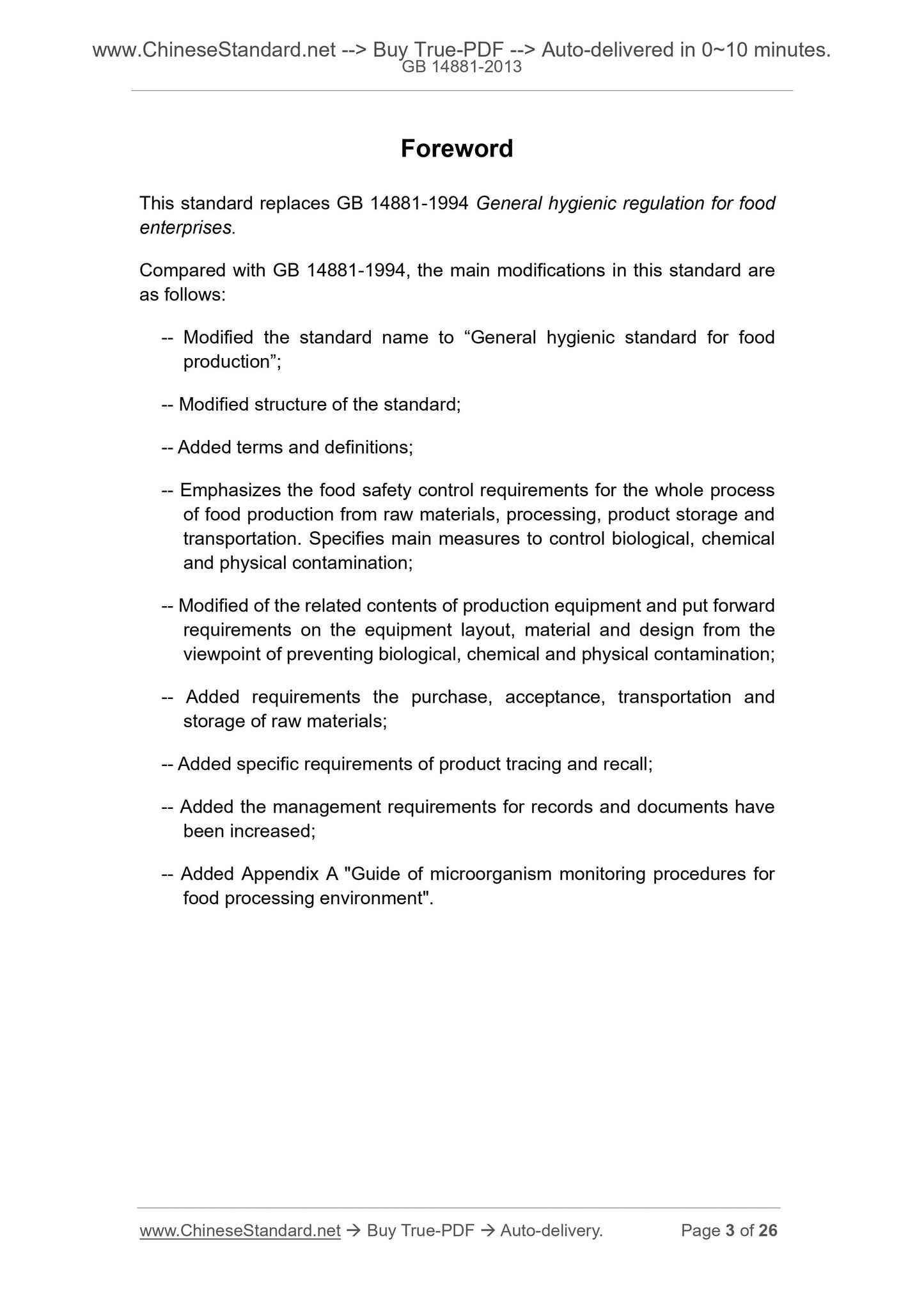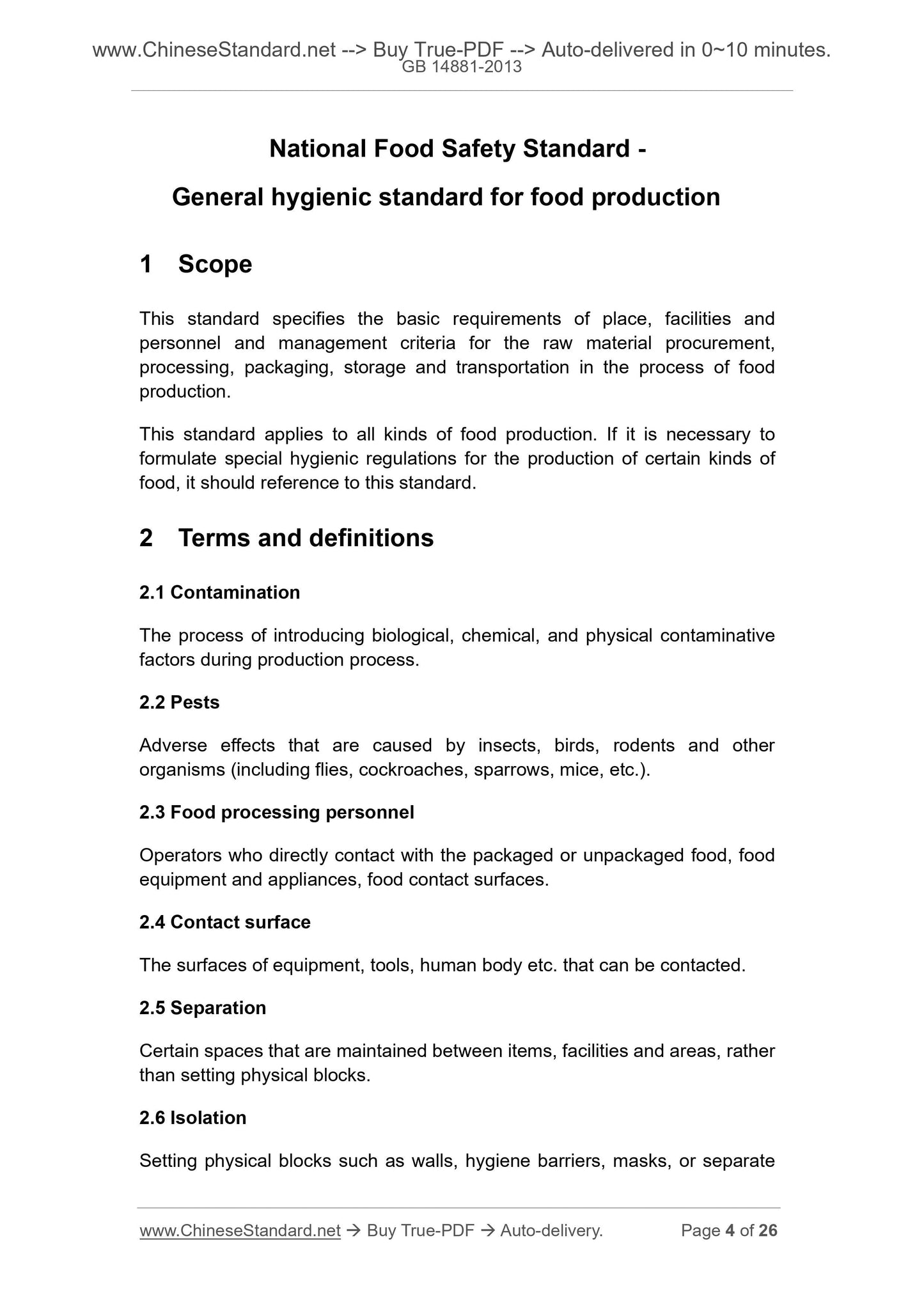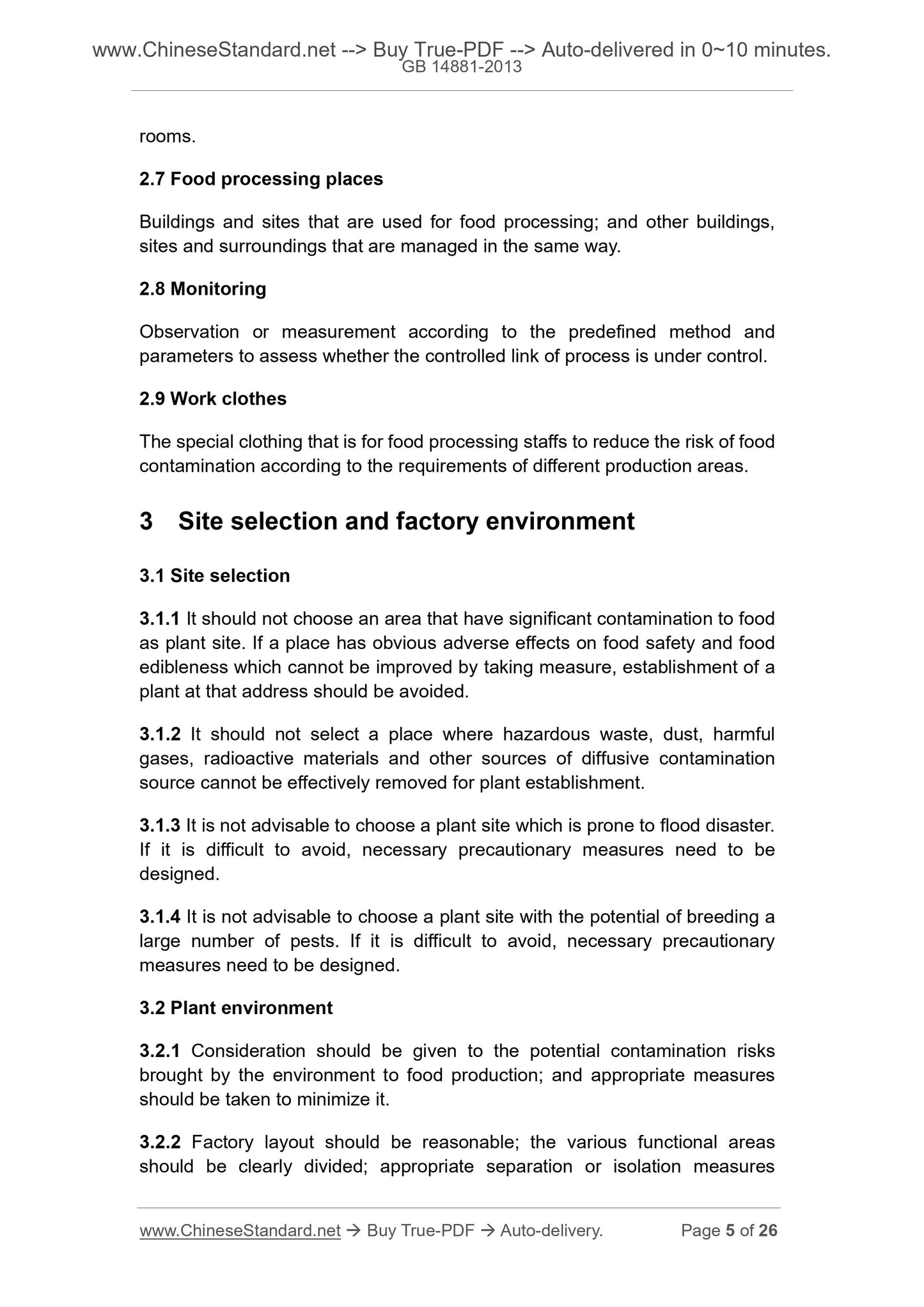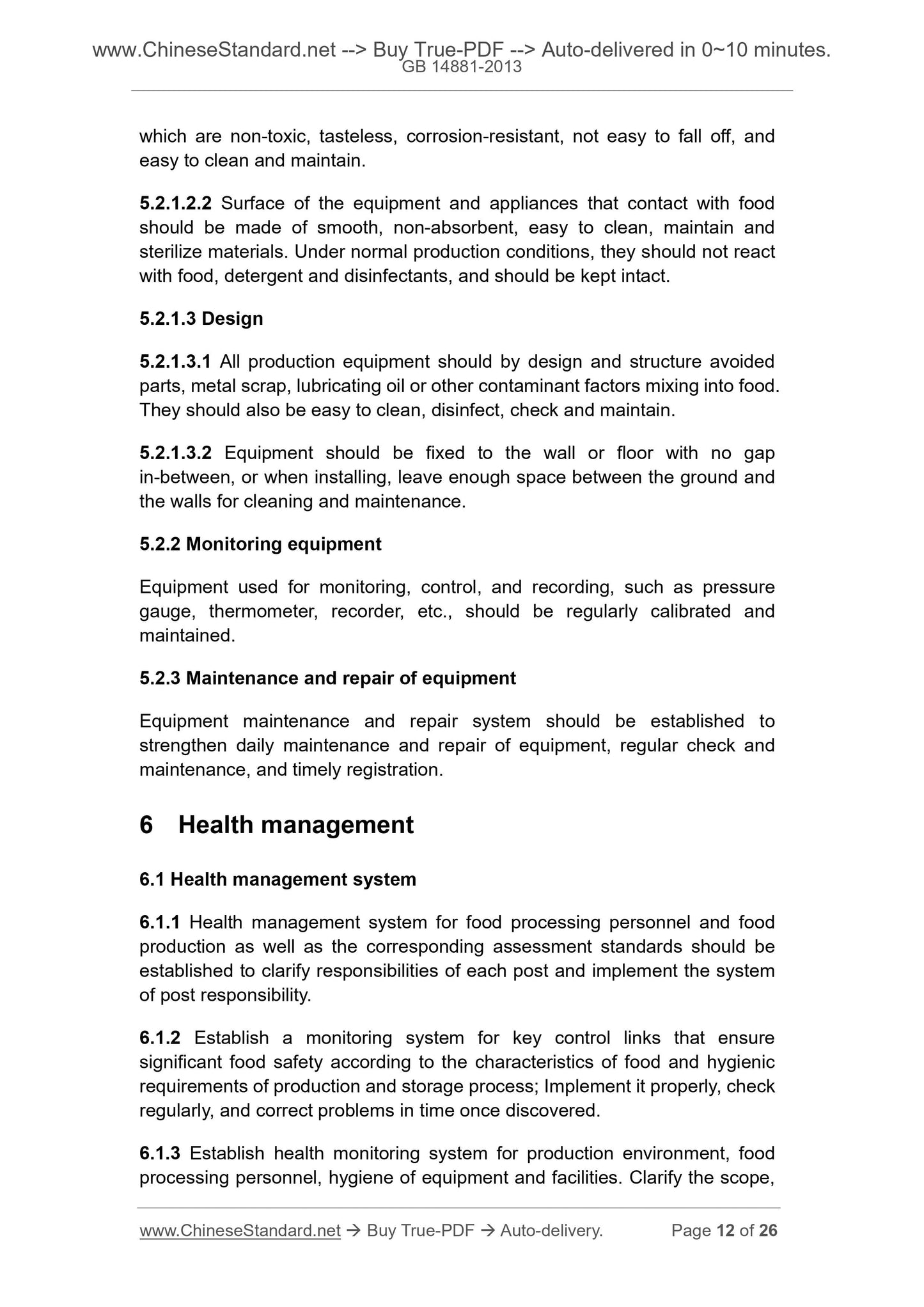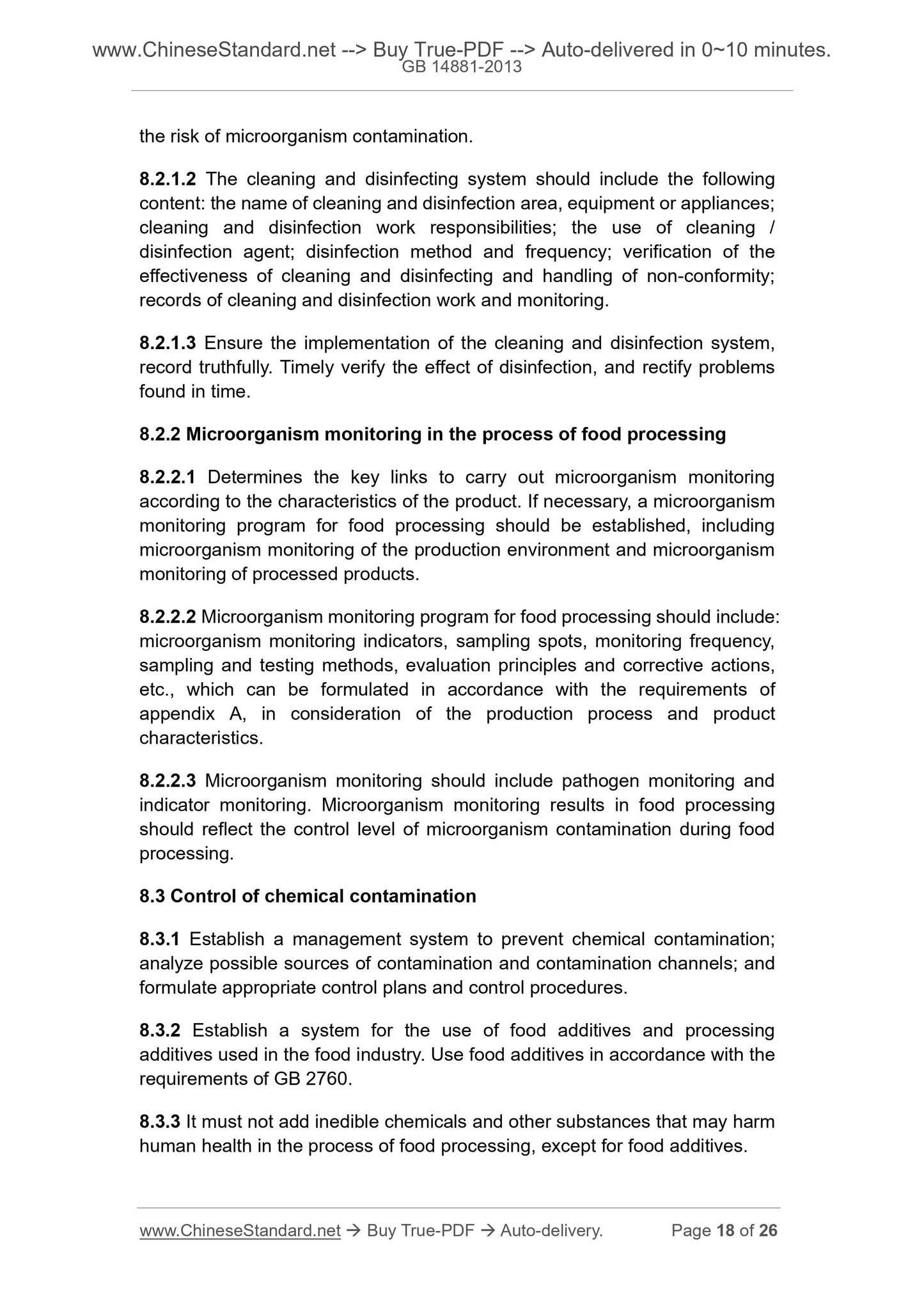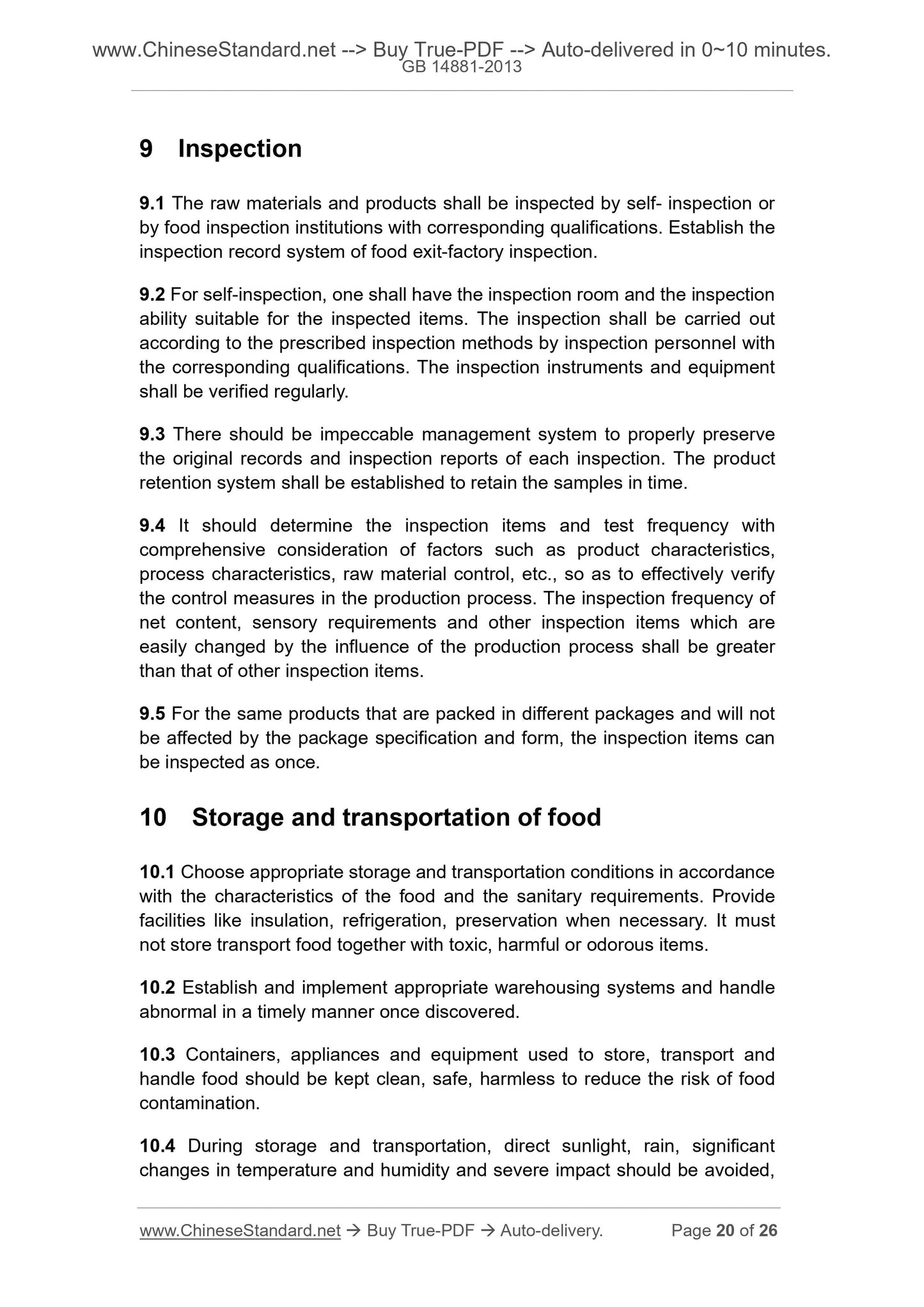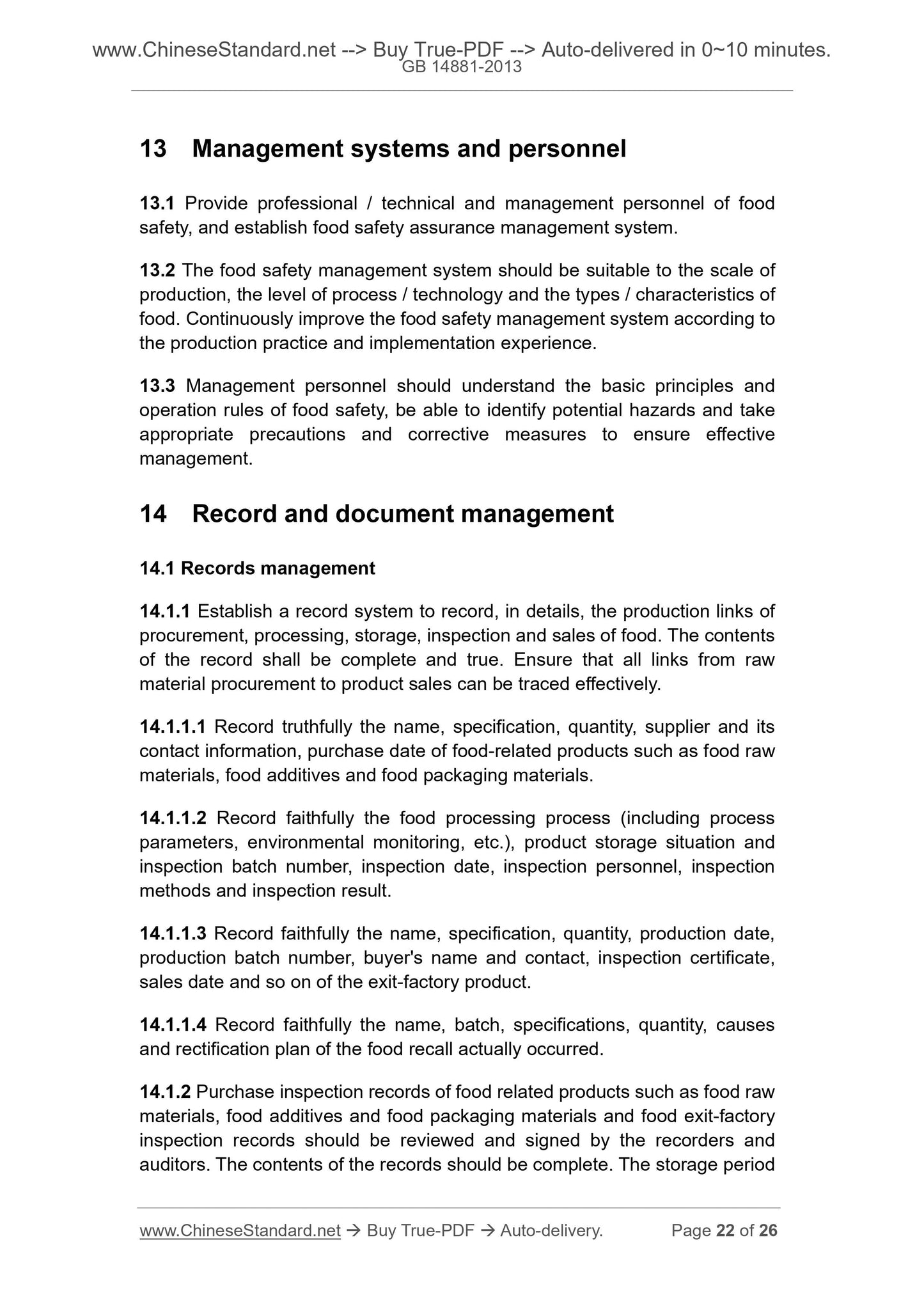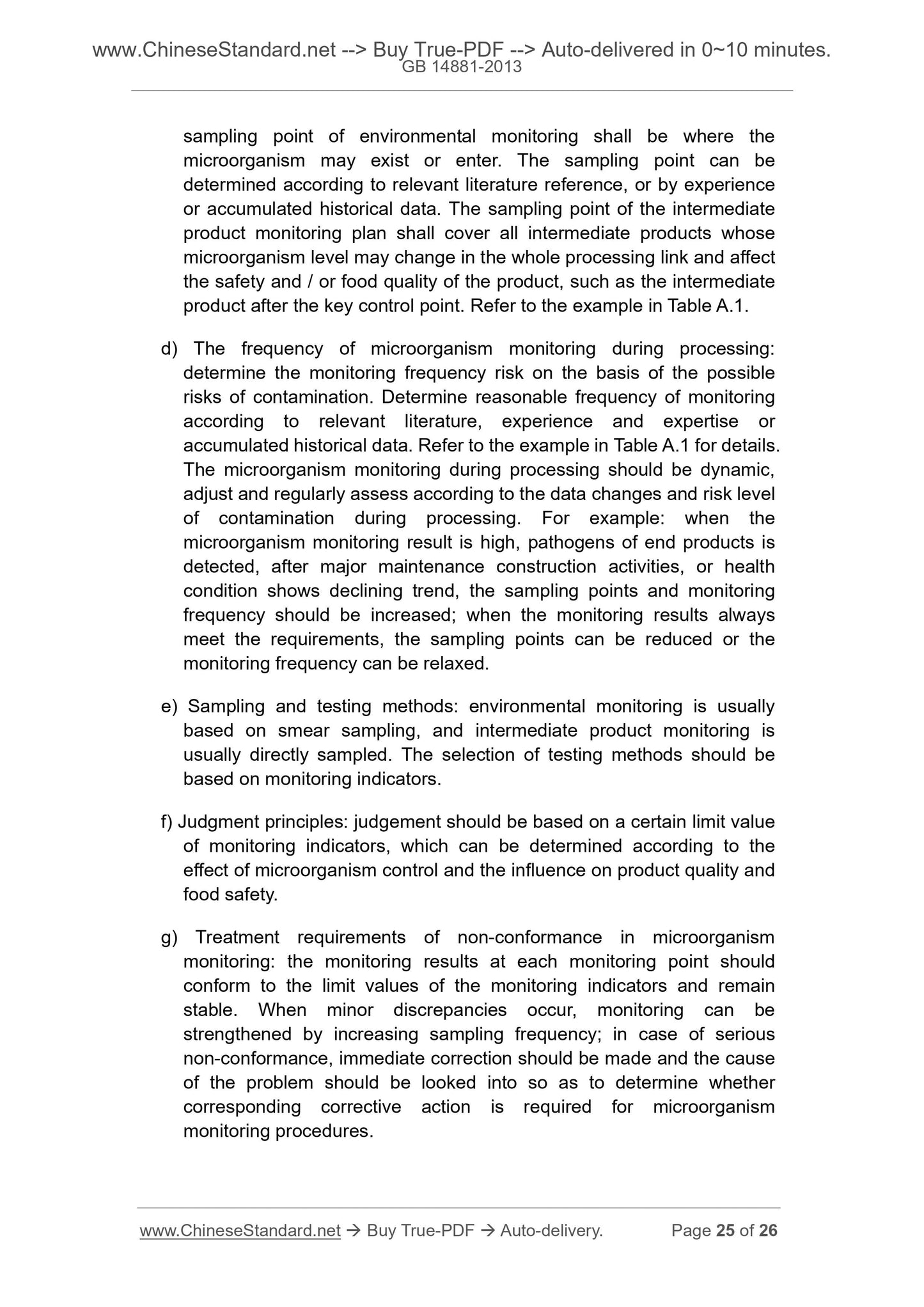1
/
/
11
PayPal, credit cards. Download editable-PDF & invoice in 1 second!
GB 14881-2013 English PDF (GB14881-2013)
GB 14881-2013 English PDF (GB14881-2013)
Normaalihinta
$85.00 USD
Normaalihinta
Alennushinta
$85.00 USD
Yksikköhinta
/
kohti
Toimituskulut lasketaan kassalla.
Noudon saatavuutta ei voitu ladata
Delivery: 3 seconds. Download true-PDF + Invoice.
Get QUOTATION in 1-minute: Click GB 14881-2013
Historical versions: GB 14881-2013
Preview True-PDF (Reload/Scroll if blank)
GB 14881-2013: General hygienic regulation for food enterprises
GB 14881-2013
GB
NATIONAL STANDARD OF THE
PEOPLE’S REPUBLIC OF CHINA
National Food Safety Standard -
General hygienic standard for food production
ISSUED ON. MAY 24, 2013
IMPLEMENTED ON. JUNE 1, 2014
Issued by. National Health and Family Planning Commission of the
People 's Republic of China
Table of Contents
Foreword ... 3
1 Scope ... 4
2 Terms and definitions ... 4
3 Site selection and factory environment ... 5
4 Plant building and workshops ... 6
5 Facilities and equipment ... 8
6 Health management ... 12
7 Food raw materials, food additives and food-related products ... 15
8 Food safety control in production process ... 17
9 Inspection ... 20
10 Storage and transportation of food ... 20
11 Product recall management ... 21
12 Training ... 21
13 Management systems and personnel ... 22
14 Record and document management ... 22
Appendix A Guide of microorganism monitoring procedures for food
processing ... 24
Foreword
This standard replaces GB 14881-1994 General hygienic regulation for food
enterprises.
Compared with GB 14881-1994, the main modifications in this standard are
as follows.
-- Modified the standard name to “General hygienic standard for food
production”;
-- Modified structure of the standard;
-- Added terms and definitions;
-- Emphasizes the food safety control requirements for the whole process
of food production from raw materials, processing, product storage and
transportation. Specifies main measures to control biological, chemical
and physical contamination;
-- Modified of the related contents of production equipment and put forward
requirements on the equipment layout, material and design from the
viewpoint of preventing biological, chemical and physical contamination;
-- Added requirements the purchase, acceptance, transportation and
storage of raw materials;
-- Added specific requirements of product tracing and recall;
-- Added the management requirements for records and documents have
been increased;
-- Added Appendix A "Guide of microorganism monitoring procedures for
food processing environment".
National Food Safety Standard -
General hygienic standard for food production
1 Scope
This standard specifies the basic requirements of place, facilities and
personnel and management criteria for the raw material procurement,
processing, packaging, storage and transportation in the process of food
production.
This standard applies to all kinds of food production. If it is necessary to
formulate special hygienic regulations for the production of certain kinds of
food, it should reference to this standard.
2 Terms and definitions
2.1 Contamination
The process of introducing biological, chemical, and physical contaminative
factors during production process.
2.2 Pests
Adverse effects that are caused by insects, birds, rodents and other
organisms (including flies, cockroaches, sparrows, mice, etc.).
2.3 Food processing personnel
Operators who directly contact with the packaged or unpackaged food, food
equipment and appliances, food contact surfaces.
2.4 Contact surface
The surfaces of equipment, tools, human body etc. that can be contacted.
2.5 Separation
Certain spaces that are maintained between items, facilities and areas, rather
than setting physical blocks.
2.6 Isolation
Setting physical blocks such as walls, hygiene barriers, masks, or separate
rooms.
2.7 Food processing places
Buildings and sites that are used for food processing; and other buildings,
sites and surroundings that are managed in the same way.
2.8 Monitoring
Observation or measurement according to the predefined method and
parameters to assess whether the controlled link of process is under control.
2.9 Work clothes
The special clothing that is for food processing staffs to reduce the risk of food
contamination according to the requirements of different production areas.
3 Site selection and factory environment
3.1 Site selection
3.1.1 It should not choose an area that have significant contamination to food
as plant site. If a place has obvious adverse effects on food safety and food
edibleness which cannot be improved by taking measure, establishment of a
plant at that address should be avoided.
3.1.2 It should not select a place where hazardous waste, dust, harmful
gases, radioactive materials and other sources of diffusive contamination
source cannot be effectively removed for plant establishment.
3.1.3 It is not advisable to choose a plant site which is prone to flood disaster.
If it is difficult to avoid, necessary precautionary measures need to be
designed.
3.1.4 It is not advisable to choose a plant site with the potential of breeding a
large number of pests. If it is difficult to avoid, necessary precautionary
measures need to be designed.
3.2 Plant environment
3.2.1 Consideration should be given to the potential contamination risks
brought by the environment to food production; and appropriate measures
should be taken to minimize it.
3.2.2 Factory layout should be reasonable; the various functional areas
should be clearly divided; appropriate separation or isolation measures
water-sealed floor drain device, to prevent the solid waste going into and
foul-gas escaping from the sewage.
5.1.2.3 The exit of the drainage system should have appropriate measures to
reduce the risk of insect pests.
5.1.2.4 The flow of indoor drainage should from areas with high cleanliness
requirements to areas with lower cleanliness requirements and should be
designed to prevent backflow.
5.1.2.5 The sewage shall be treated in a proper manner before discharge to
comply with the relevant regulations of the national sewage discharge.
5.1.3 Cleaning and sterilizing facilities
Adequate cleaning facilities for food, appliances and equipment should be
provided. Suitable sterilizing facilities should be provided if necessary. Proper
measures should be taken to avoid cross contamination caused by cleaning
and sterilizing.
5.1.4 Waste storage facilities
Special facilities for storing wastes that are reasonably designed, leak-proof
and easy to clean should be equipped. The facilities and containers for
storing wastes in the workshop should be clearly identified. If necessary,
temporary storage facilities should be set up at appropriate locations and
stored according to the characteristics of wastes.
5.1.5 Personal sanitation facilities
5.1.5.1 A locker room should be set up at the entrance of production site or
workshop. When necessary, a locker room can be set at the entrance of a
specific operation area. The locker room should ensure that the work clothes
are separately placed with personal clothing and other items.
5.1.5.2 Shoes changing (shoes wearing set) facilities or working shoes /
boots disinfection facilities should be provided at the entrance of workshop
and necessary spots in the workshop. If shoes / boots disinfection facilities
are set up, their specifications and sizes should meet the needs of
disinfection.
5.1.5.3 Toilets should be set up according to needs. The structure, facilities
and internal materials of toilets should be easy to keep clean. Hands washing
facilities should be set up in the proper position of the toilets. The toilets
should not be directly connected with food production, packaging or storage
areas.
5.1.8 Storage facilities
5.1.8.1...
Get QUOTATION in 1-minute: Click GB 14881-2013
Historical versions: GB 14881-2013
Preview True-PDF (Reload/Scroll if blank)
GB 14881-2013: General hygienic regulation for food enterprises
GB 14881-2013
GB
NATIONAL STANDARD OF THE
PEOPLE’S REPUBLIC OF CHINA
National Food Safety Standard -
General hygienic standard for food production
ISSUED ON. MAY 24, 2013
IMPLEMENTED ON. JUNE 1, 2014
Issued by. National Health and Family Planning Commission of the
People 's Republic of China
Table of Contents
Foreword ... 3
1 Scope ... 4
2 Terms and definitions ... 4
3 Site selection and factory environment ... 5
4 Plant building and workshops ... 6
5 Facilities and equipment ... 8
6 Health management ... 12
7 Food raw materials, food additives and food-related products ... 15
8 Food safety control in production process ... 17
9 Inspection ... 20
10 Storage and transportation of food ... 20
11 Product recall management ... 21
12 Training ... 21
13 Management systems and personnel ... 22
14 Record and document management ... 22
Appendix A Guide of microorganism monitoring procedures for food
processing ... 24
Foreword
This standard replaces GB 14881-1994 General hygienic regulation for food
enterprises.
Compared with GB 14881-1994, the main modifications in this standard are
as follows.
-- Modified the standard name to “General hygienic standard for food
production”;
-- Modified structure of the standard;
-- Added terms and definitions;
-- Emphasizes the food safety control requirements for the whole process
of food production from raw materials, processing, product storage and
transportation. Specifies main measures to control biological, chemical
and physical contamination;
-- Modified of the related contents of production equipment and put forward
requirements on the equipment layout, material and design from the
viewpoint of preventing biological, chemical and physical contamination;
-- Added requirements the purchase, acceptance, transportation and
storage of raw materials;
-- Added specific requirements of product tracing and recall;
-- Added the management requirements for records and documents have
been increased;
-- Added Appendix A "Guide of microorganism monitoring procedures for
food processing environment".
National Food Safety Standard -
General hygienic standard for food production
1 Scope
This standard specifies the basic requirements of place, facilities and
personnel and management criteria for the raw material procurement,
processing, packaging, storage and transportation in the process of food
production.
This standard applies to all kinds of food production. If it is necessary to
formulate special hygienic regulations for the production of certain kinds of
food, it should reference to this standard.
2 Terms and definitions
2.1 Contamination
The process of introducing biological, chemical, and physical contaminative
factors during production process.
2.2 Pests
Adverse effects that are caused by insects, birds, rodents and other
organisms (including flies, cockroaches, sparrows, mice, etc.).
2.3 Food processing personnel
Operators who directly contact with the packaged or unpackaged food, food
equipment and appliances, food contact surfaces.
2.4 Contact surface
The surfaces of equipment, tools, human body etc. that can be contacted.
2.5 Separation
Certain spaces that are maintained between items, facilities and areas, rather
than setting physical blocks.
2.6 Isolation
Setting physical blocks such as walls, hygiene barriers, masks, or separate
rooms.
2.7 Food processing places
Buildings and sites that are used for food processing; and other buildings,
sites and surroundings that are managed in the same way.
2.8 Monitoring
Observation or measurement according to the predefined method and
parameters to assess whether the controlled link of process is under control.
2.9 Work clothes
The special clothing that is for food processing staffs to reduce the risk of food
contamination according to the requirements of different production areas.
3 Site selection and factory environment
3.1 Site selection
3.1.1 It should not choose an area that have significant contamination to food
as plant site. If a place has obvious adverse effects on food safety and food
edibleness which cannot be improved by taking measure, establishment of a
plant at that address should be avoided.
3.1.2 It should not select a place where hazardous waste, dust, harmful
gases, radioactive materials and other sources of diffusive contamination
source cannot be effectively removed for plant establishment.
3.1.3 It is not advisable to choose a plant site which is prone to flood disaster.
If it is difficult to avoid, necessary precautionary measures need to be
designed.
3.1.4 It is not advisable to choose a plant site with the potential of breeding a
large number of pests. If it is difficult to avoid, necessary precautionary
measures need to be designed.
3.2 Plant environment
3.2.1 Consideration should be given to the potential contamination risks
brought by the environment to food production; and appropriate measures
should be taken to minimize it.
3.2.2 Factory layout should be reasonable; the various functional areas
should be clearly divided; appropriate separation or isolation measures
water-sealed floor drain device, to prevent the solid waste going into and
foul-gas escaping from the sewage.
5.1.2.3 The exit of the drainage system should have appropriate measures to
reduce the risk of insect pests.
5.1.2.4 The flow of indoor drainage should from areas with high cleanliness
requirements to areas with lower cleanliness requirements and should be
designed to prevent backflow.
5.1.2.5 The sewage shall be treated in a proper manner before discharge to
comply with the relevant regulations of the national sewage discharge.
5.1.3 Cleaning and sterilizing facilities
Adequate cleaning facilities for food, appliances and equipment should be
provided. Suitable sterilizing facilities should be provided if necessary. Proper
measures should be taken to avoid cross contamination caused by cleaning
and sterilizing.
5.1.4 Waste storage facilities
Special facilities for storing wastes that are reasonably designed, leak-proof
and easy to clean should be equipped. The facilities and containers for
storing wastes in the workshop should be clearly identified. If necessary,
temporary storage facilities should be set up at appropriate locations and
stored according to the characteristics of wastes.
5.1.5 Personal sanitation facilities
5.1.5.1 A locker room should be set up at the entrance of production site or
workshop. When necessary, a locker room can be set at the entrance of a
specific operation area. The locker room should ensure that the work clothes
are separately placed with personal clothing and other items.
5.1.5.2 Shoes changing (shoes wearing set) facilities or working shoes /
boots disinfection facilities should be provided at the entrance of workshop
and necessary spots in the workshop. If shoes / boots disinfection facilities
are set up, their specifications and sizes should meet the needs of
disinfection.
5.1.5.3 Toilets should be set up according to needs. The structure, facilities
and internal materials of toilets should be easy to keep clean. Hands washing
facilities should be set up in the proper position of the toilets. The toilets
should not be directly connected with food production, packaging or storage
areas.
5.1.8 Storage facilities
5.1.8.1...
Share
